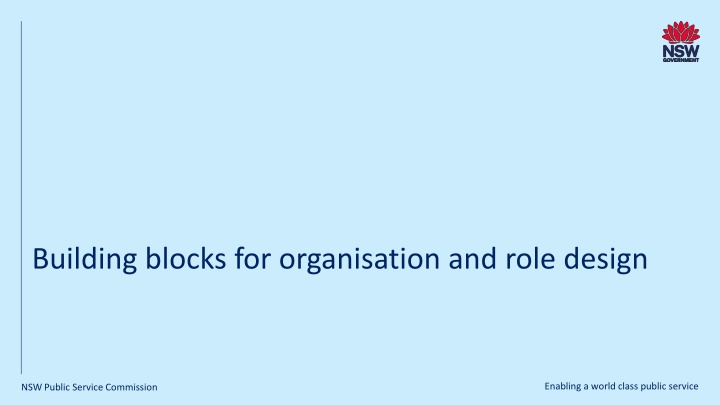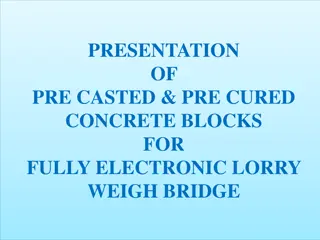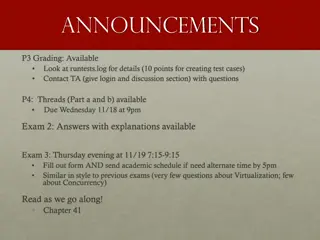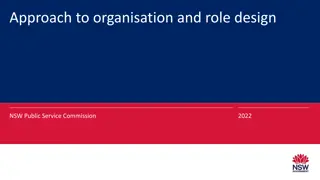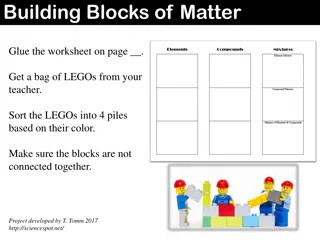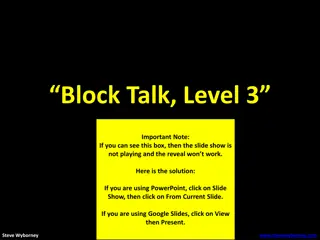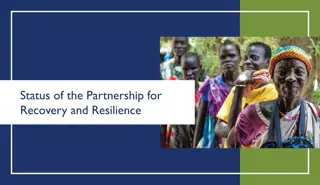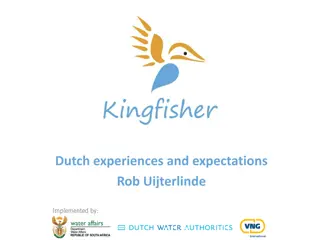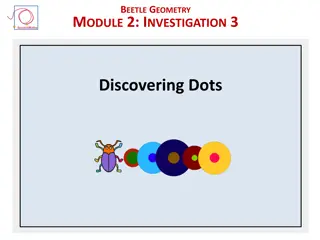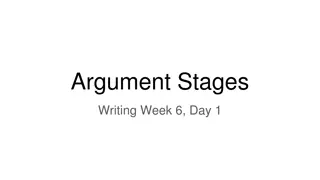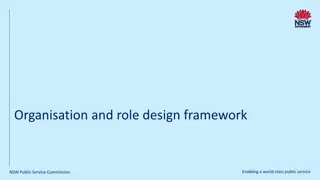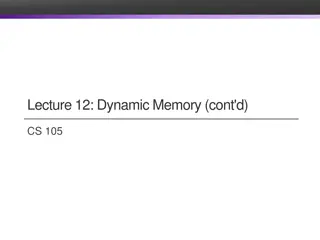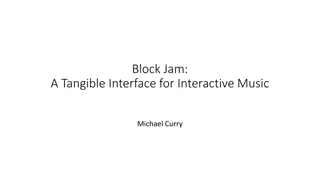Building blocks for organisation and role design
The building blocks for organisation and role design are crucial in developing a modern and integrated organisational structure. Key stakeholders from various teams such as Development, Health, Safety and Wellbeing, and Employee/Industrial Relations need to be involved for effective design. The involvement of key stakeholders outside HR is essential. The process involves scoping, consultation, and review at key milestones to ensure alignment with organisational goals. Questions related to direction, customer focus, culture, diversity and inclusion, and governance are integral to the design process.
Download Presentation

Please find below an Image/Link to download the presentation.
The content on the website is provided AS IS for your information and personal use only. It may not be sold, licensed, or shared on other websites without obtaining consent from the author.If you encounter any issues during the download, it is possible that the publisher has removed the file from their server.
You are allowed to download the files provided on this website for personal or commercial use, subject to the condition that they are used lawfully. All files are the property of their respective owners.
The content on the website is provided AS IS for your information and personal use only. It may not be sold, licensed, or shared on other websites without obtaining consent from the author.
E N D
Presentation Transcript
Building blocks for organisation and role design Enabling a world class public service NSW Public Service Commission
What are the building blocks for organisation and role design? The building blocks are fundamental in developing a modern and integrated organisation design. It will inform the design principles, restructure approach, roadmap and the rationale behind the change. which areas your organisation needs to focus on. Development, Health, Safety and Wellbeing, and Employee/Industrial Relations teams Other subject matter experts: including staff in finance, strategy, risks, data and insights, and governance Who needs to be involved? To be effective, organisation and role design should not be seen as just a HR function. It is essential to have support and participation from key stakeholders in the business to explore the building blocks of effective organisation and role design. Once you have identified which building blocks are relevant to your organisation, you will need to identify which stakeholders to engage in the scoping and consultation sessions (Identify stage). How do I use them? The building blocks should be considered at the beginning of the organisation redesign process. As each organisation is unique, it is important for you to decide which building block you need to spend most of your time on. The building blocks may also be reviewed at key milestones throughout the design process to keep design decisions and activities on track and address any emerging challenges or risks. Key questions are provided on the next couple of pages to guide your review of each building block and determine As a guide, the following stakeholder groups will need to be involved in the scoping and consultation sessions: Business: senior decision makers and people managers Human Resources: relevant HR Business Partners, and staff in the Organisational Change and NSW Public Service Commission Enabling a world class public service 2
Descriptor Enabling a world class public service 3
Building block 1: Direction Questions Sources Design principle examples Your organisation s mission and vision statement Business and strategic plans Strategic workforce plan Operating model Strategy What are your organisation's strategic objectives? Do you anticipate any changes to your organisation s strategic priorities? Be defined and organised by our strategic direction, goals and priorities Your organisation s surveys highlighting customers experience Outputs from focus groups Customer at the centre Who are our customers? What are our customers saying and doing? What are our customers expectations? Empower our customers by bringing decision making closer to them The core values for the government sector outlined in the Ethical Framework Your organisation s culture, values and behaviour statements PMES results and action plan Culture, values and behaviours What is our culture like? How can we build and maintain a positive culture? What are our agency s values? How do they affect the way change should be managed? What behaviours do we need to deliver our operational and strategic objectives? Build a safe and positive workplace culture Your organisation s Diversity and Inclusion Plan Your organisation s Equal Employment Opportunity (EEO) data and benchmarking towards the Premier s Priority 14 Diversity and inclusion What are our objectives and KPIs for diversity and inclusion? How can we align our organisation redesign priorities with our D&I targets? Achieve our diversity and inclusion aspirations by creating better opportunities and pathways Your organisation s governance and risks strategy Change management approaches documenting previous methods Governance and risks What are some key risks facing your organisation? Do we have effective processes in place to address, manage and mitigate risks? Optimise our organisation design to better manage risks NSW Public Service Commission Enabling a world class public service 4
Building block 2: Ways of Working Questions Sources Design principle examples What work can be done synchronously or asynchronously? What do we need to do to support flexible ways of working? What strategies can we employ to connect our employees working flexibly? The NSW PSC s flexible working resources and guidance on role redesign for employees Flexible/ hybrid Embed flexible ways of working to retain our critical and accelerator roles How do we work, collaborate and share information? How does this way of working enable us to meet our strategic and operational objectives? What are our approaches to work (e.g., human centered design, agile, devolved accountability)? Your organisation s divisional plans and divisional value propositions A functional analysis of your current organisational state How we work together Modernise our ways of working to meet our strategic objectives How can we incorporate digital capabilities in designing our roles, and our recruitment and performance development processes? Are there opportunities to automate or augment tasks to increase capacity and improve outcomes? What capabilities are needed to support the rapid increase of technology and meet future business demands? Your organisation s service delivery model, performance insights data, and workforce data (e.g. headcount, unit) Refer to the National Skills Commission for information on skills priority, shortages and employment projections, to understand digital workforce supply and demand Digital enablers Design roles to integrate technology in our processes and build our digital capabilities What capabilities and mindsets do we need to achieve our operational and strategic objectives? What are the accelerator roles in our organisation that will help us meet our strategic objectives? Refer to the NSW Capability Framework and the occupation specific capability sets Capabilities and mindsets Design roles that address our capability gaps in artificial intelligence NSW Public Service Commission Enabling a world class public service 5
Building block 3: How we are organised Questions Sources Design principle examples How are we currently organised (i.e., functional, geographical, hierarchical, matrix etc.)? How well is the current structure enabling achievement of business value and productivity? What are the benefits and constraints of other organisational model options? Your organisation s chart Research other organisation's structure and operating models Organisational chart Increase productivity by choosing a sustainable operating model that meets future needs What do we want to achieve with sizing, spans of control and layers? How can spans of control and layers promote employee engagement, accountability, career paths, wellbeing, flexibility etc? Are critical decisions being made at the right level and in the right business unit? Your organisation s chart Refer to the APS Framework for Optimal Management Structures Refer to the NSW Senior Executive Work Level Standards Sizing, spans and layers Build an optimal management structure that devolves decision making to the lowest practical level What role classifications and structure will we need? What are our budget constraints? What role classifications do we need to achieve our strategic priorities? Your organisation s strategic and budget plans Your organisation's establishment report Classifications Build a structure that maximises the opportunity to proactively and flexibly respond to change What are the outcomes our roles need to deliver? How can we ensure our position descriptions are designed consistently? Where are the more generalist and/or specialist roles needed, to achieve our strategic objectives and KPIs? Your organisation s strategic plan and position description library Research the PSC's Role Description webpage for information and resources on building role descriptions Role descriptions Eliminate existing inefficiencies and duplication of work through better role design NSW Public Service Commission Enabling a world class public service 6
Building block 4: Boundaries Questions Sources Design principle examples What are our current workforce and industrial relations frameworks? How will these influence our approach to design and implementation? Are there any opportunities to change these frameworks to help meet our agency s objectives? Does the current classification structure enable or constrain decision- making at the right levels? What rules, constraints or legislative structures guide sizing decisions? Refer to the Government Sector Employment Act 2013 Refer to the workforce transition and Managing Excess Employees (MEE) Guidelines Workforce and Industrial Relations (IR) Legislative Frameworks Modernise our organisational design to improve accountability and decision making What policies, procedures and delegations will influence our design choices? Are there opportunities to update our policies, procedures and/or delegations to meet our needs? Your organisation s policy and procedures register Policies, procedures and delegations Develop consistency in job classification to build clarity of role expectations and accountabilities NSW Public Service Commission Enabling a world class public service 7
